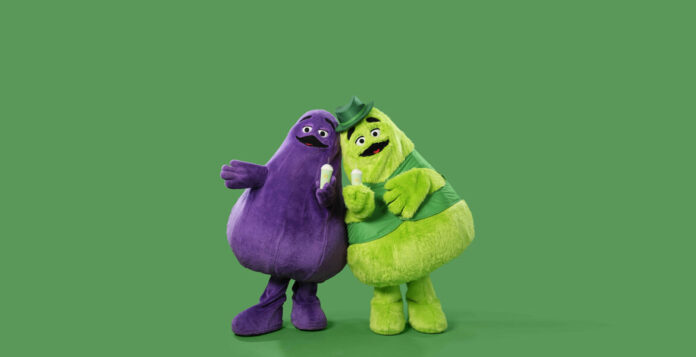When you hear Grimace McDonald, you might picture a big fuzzy purple character hopping around a playground or sharing a milkshake with Ronald McDonald. But the story of this unlikely mascot is far richer and more curious than that.
In this article, we’ll explore the full arc of the Grimace McDonald’s phenomenon—how he began, changed, became part of pop culture, and what marketers and fans can learn from him. By the end, you’ll understand why a character originally designed for kids still gets social-media buzz decades later and what the term “Grimace McDonald’s” truly represents.
Origins of grimace mcdonalds Character
Grimace was introduced by McDonald’s in the early 1970s as part of the “McDonaldland” universe—a colorful world filled with characters that made dining at McDonald’s feel like an adventure for children.
Originally, Grimace debuted in 1971 under the name “Evil Grimace.” He had four arms and was portrayed as a mischievous villain who stole milkshakes and sodas from the residents of McDonaldland.
This was part of a larger marketing effort to bring storytelling and imagination into the fast-food experience. McDonald’s wasn’t just selling burgers; it was selling a feeling of fun, magic, and playfulness that extended beyond the restaurant walls.
Evolution: From Four Arms to Purple Plush grimace mcdonalds
The transformation of Grimace McDonald’s over the years is one of the most fascinating examples of brand adaptation.
- 1971: Evil Grimace makes his debut, four arms, and a villainous streak.
- 1972 onward: The character returns with two arms, a friendlier personality, and a shortened name—simply Grimace.
- Over time, Grimace evolves into a kind-hearted, childlike sidekick who loves milkshakes and spends time with Ronald McDonald and friends.
The change happened because McDonald’s realized the original version frightened some children. By softening his appearance and making him friendly, the brand made Grimace more appealing and lovable.
This redesign marked the birth of the Grimace McDonald’s most people know today—the cheerful purple character with a goofy grin and endless enthusiasm for milkshakes.
What Is Grimace? The Identity Question grimace mcdonalds
For decades, fans have asked: What exactly is Grimace McDonald’s supposed to be?
Some claim he’s a giant taste bud. Others insist he represents a milkshake, an amorphous blob, or simply “the essence of joy.” McDonald’s itself has offered several playful explanations over the years, saying Grimace is either “the embodiment of a milkshake” or “a friendly taste bud.”
This ambiguity has only added to his charm. Unlike other mascots with clear animal or human traits, Grimace’s identity is open-ended, allowing fans to interpret him in their own ways. That flexibility has kept him relevant through generations.
grimace mcdonalds in Popular Culture
Grimace became more than a commercial mascot—he grew into a pop-culture symbol.
Throughout the 1970s and 1980s, Grimace featured prominently in McDonald’s commercials, playgrounds, and merchandise. He was part of the McDonaldland cast, alongside characters like Ronald McDonald, the Hamburglar, Birdie the Early Bird, and Mayor McCheese.
Grimace’s family was even expanded in some marketing stories. His green uncle, Uncle O’Grimacey, appeared during St. Patrick’s Day promotions to promote the Shamrock Shake.
In recent years, Grimace has re-emerged online as an internet meme and nostalgic icon. Fans on social media celebrate his lovable weirdness, often creating humorous or surreal videos and artwork featuring the purple character.
His combination of nostalgia and absurdity makes Grimace McDonald’s a perfect subject for the modern meme era—funny, mysterious, and deeply recognizable.
The Viral Phenomenon: grimace mcdonalds
In June 2023, McDonald’s launched the Grimace Shake to celebrate the character’s “birthday.” The limited-edition drink was a berry-flavored milkshake with a bright purple hue, served alongside themed packaging and merchandise.
The promotion instantly went viral. TikTok users began posting videos under the “Grimace Shake trend,” where they would drink the shake and then humorously “collapse” or “disappear” in bizarre horror-movie-style edits.
McDonald’s leaned into the trend with lighthearted social-media engagement, letting fans have fun with the viral energy instead of trying to control it.
The Grimace Shake wasn’t just a product—it was a cultural event. It reminded everyone that even decades-old mascots can thrive in the digital age when brands understand the power of nostalgia and creativity.
Marketing Lessons from grimace mcdonalds
The story of Grimace McDonald’s provides valuable marketing insights:
- Evolve with the audience: Grimace went from villain to hero because McDonald’s adapted him to fit changing tastes.
- Nostalgia sells: The 2023 Grimace Shake campaign worked because it tapped into millennial and Gen Z nostalgia.
- Embrace ambiguity: By keeping Grimace’s identity vague, McDonald’s allowed him to become whatever fans wanted him to be.
- Meet fans where they are: Instead of pushing ads, McDonald’s joined the social conversation around the Grimace Shake.
- Stay playful: Humor and creativity keep audiences engaged far longer than straightforward promotion.
Grimace shows that even in a competitive market, personality and authenticity can turn a mascot into a legend.
Why grimace mcdonalds Still Matters Today
Decades after his debut, Grimace McDonald continues to hold cultural significance.
- Intergenerational appeal: Parents who grew up with Grimace now introduce him to their children.
- Memetic potential: His look and personality are perfect for social-media humor.
- Symbol of fun: Grimace embodies McDonald’s playful brand identity—joyful, friendly, and inclusive.
- Marketing resilience: He proves that old mascots can become relevant again when given a modern twist.
In a world where brands come and go, Grimace’s longevity is a testament to strong character design, adaptability, and emotional connection.
Conclusion grimace mcdonalds
The journey of Grimace McDonald’s—from a four-armed milkshake thief to a lovable purple icon—is a masterclass in branding, nostalgia, and cultural evolution.
Grimace isn’t just a relic of the past. He’s proof that characters with heart, humor, and mystery can thrive across generations. Whether you remember him from childhood commercials or discovered him through the viral Grimace Shake, his charm remains timeless.
FAQs
Q1: When was Grimace McDonald’s first introduced?
Grimace made his debut in 1971 as “Evil Grimace,” a milkshake-stealing character in early McDonald’s commercials.
Q2: Why did Grimace have four arms originally?
He was designed with four arms to grab milkshakes, but the design frightened children, so McDonald’s changed him to two arms in later versions.
Q3: What is the Grimace Shake?
The Grimace Shake was a limited-edition purple milkshake released in 2023 to celebrate Grimace’s birthday. It became a viral sensation online.
Q4: What is Grimace supposed to be?
McDonald’s has described him as a friendly “taste bud” or “embodiment of a milkshake,” leaving his exact identity open to interpretation.
Q5: Why is Grimace McDonald’s important for marketing?
His evolution shows how nostalgia, humor, and cultural relevance can keep a brand character alive and loved for decades.


